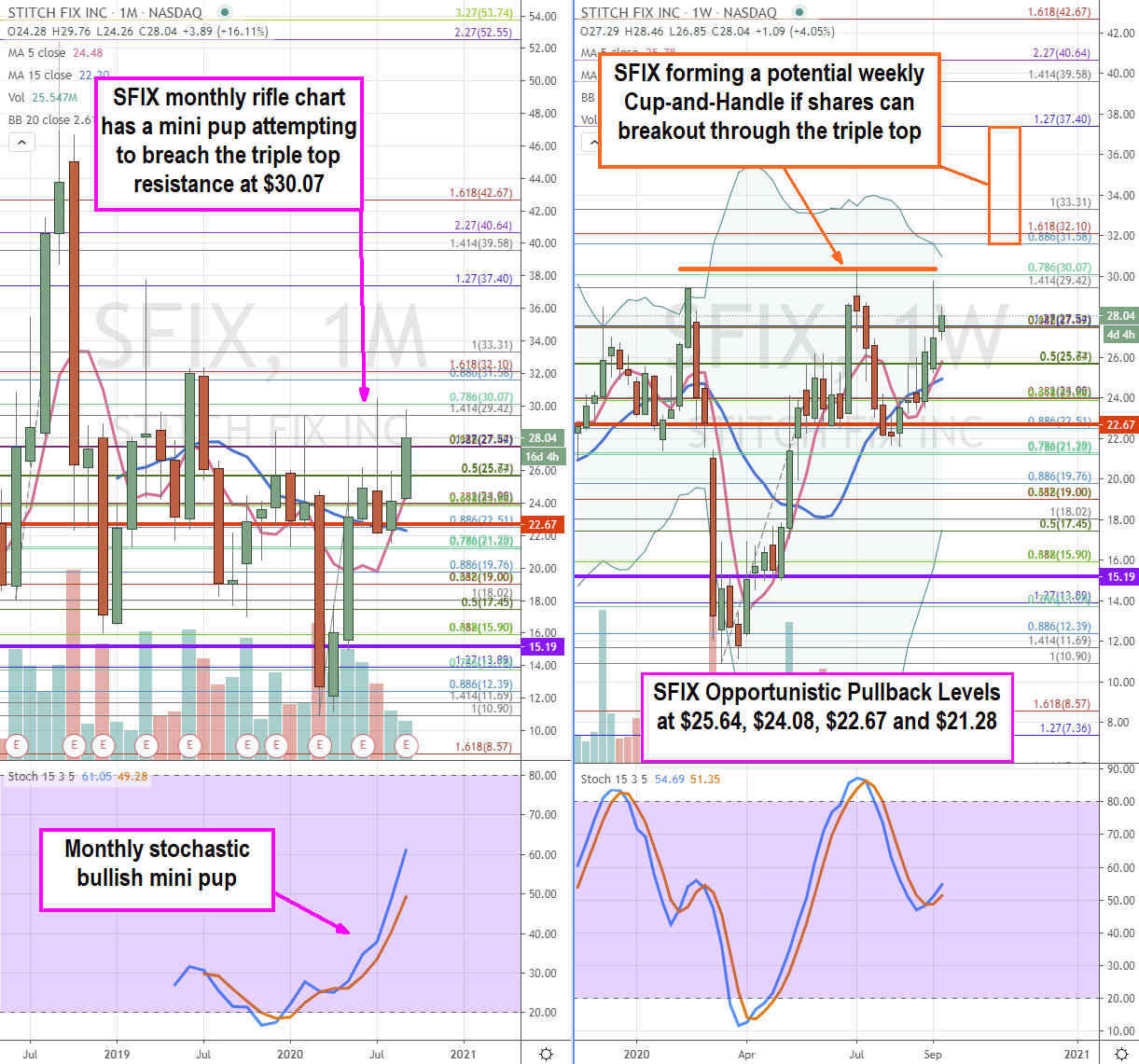Online styling and apparel retailer platform
Stitch Fix NASDAQ: SFIX shares have been in a slow but steady recovery as restarts accelerate. While the Company is an ecommerce play, it has largely been ignored by the ecommerce momentum buyers since the pandemic triggered isolation mandates stifled the demand for fashion and business casual apparel. Instead,
demand for athleisure ,
comfort wear and
accessories were the winners. As workers return to offices and social engagements, the demand should migrate back to Stitch Fix’s wheelhouse making it a recovery narrative play. Prudent investors should monitor opportunistic pullbacks off the triple top resistance to step into the recovery trade especially as a COVID-19 vaccine approval nears.
Q3 FY 2020 Earnings Release
On June 8, 2020, Stich Fix released its third-quarter fiscal 2020 results for the quarter ending May 2020. TheCompany reported earnings-per-share (EPS) loss of (-$0.33) excluding non-recurring items versus consensus analyst estimates for a loss of (-$0.15), a (-$0.33) per share miss. Revenues dropped (-9.09%) year-over-year (YoY) to $371.73 million, falling short of consensus estimates by (-$42.82) million. Some of the highlights of the quarter include a 9.4% YoY rise in active clients to 3.4 million and rise of 6% YoY in net revenue per client to $498. The Company delivered a positive YoY growth in net merchandise revenues for the month of May 2020.
Conference Call Takeaways
Stitch Fix CEO Katrina Lake painted a positive narrative on the quarter pointing out that, “While massive apparel retail declined 80% in recent months, we saw only a (-9%) YoY dip that’s to the resilience of our large auto-ship client base and the strength of Direct Buy.” Lake anticipates a stronger consumer shift to frictionless online from traditional brick and mortar as a result of the pandemic, which is the Company’s core sweet spot. Stitch Fix President Elizabeth Spalding estimates $30 billion will “rapidly” shift online which is 3X more than a typical year. The Company’s auto-ship program saw an opt-out uptick during pandemic peaks in April but quickly saw a recovery in May underscoring the best retention rate in three years. Direct Buy is a low commitment but low friction gateway to the Company’s personal shopping experience, the “Fix” offerings. Direct Buy saw “no signs of abatement” in Q3 tracking above its pre-COVID estimates despite the pandemic backdrop again underscoring the resiliency of its growing customer base.
Parlaying the Growth
The boost in active clients and average revenue per client are the key drivers positioning Stich Fix for a growth surge as economic restarts accelerate. Due to the stay-at-home mandates, many consumers were introduced to the Stich Fix platform despite the (-25%) drop in marketing expenses. The Company has started ramp up marketing efforts as isolation restrictions get lifted. The bottom line here is that as people return to social and professional engagements, its time to update the wardrobe. This is causing the run ups in the brick and mortar retailers as money rotates into value from growth momentum names. Stitch Fix happens to be a technology play with consumer discretionary products that benefits more from the recovery narrative. The pandemic opened the floodgates for online and mobile sales channels, Stitch Fix benefits from that as the demand for its wares rebound. Prudent investors should watch the reaction to the triple top-level and Q4 FY2020 earnings due out Sept. 22, 2020, for opportunistic pullback entries.

SFIX Opportunistic Pullback Price Levels
Using the rifle charts on the monthly and weekly time frames provides a broader view of the landscape for SFIX stock. The monthly rifle chart triggered market structure low (MSL) buy above $15.19 as it triggered a monthly mini pup breakout. However, SFIX has put in very strong resistance near the $30.07 Fibonacci (fib) level resulting in a triple top. The weekly stochastic has crossed back up off the 50-band stochastic indicating a potential Cup-and-Handle formation triggering on the breakout through the triple top resistance. A rejection off that level or rug pull on its Q4 FY2020 earnings results may provide opportunistic pullback levels at the $25.64 fib, $24.08 monthly 5-period moving average and fib, $22.67 monthly MSL trigger and fib and $21.28 overlapping fib. Patience and prudence is needed to wait for pullbacks either on the test of the triple top level or on an earnings release reaction. If the earnings release forms a price gap, then look for potential entries on pullbacks retesting the triple top to see if it transforms into a support. This can enable the next leg up to the $37.40 fib range.
Thinking about investing in Meta, Roblox, or Unity? Enter your email to learn what streetwise investors need to know about the metaverse and public markets before making an investment.
Get This Free Report
Like this article? Share it with a colleague.
Link copied to clipboard.